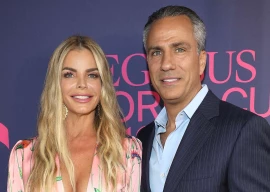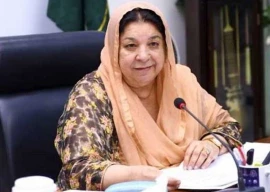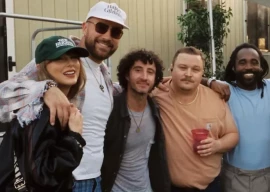
With all the bad news surrounding us, it’s easy to give into despair. But there is hope out there, and this country of ours is is filled with people who have struggled in the face of adversity and won. Here is the story of one such person.
They call him ‘Larkana’s Edhi’. And certainly, with his white beard, modest stature and soft speech, Haji Anwar Ali Khokhar does resemble Pakistan’s well-known social worker. But the similarities don’t end there; like Edhi, he too has transformed himself, and his mission, into an institution.
Simply put, Haji Anwar reunites lost children with their parents. He has made it his life’s mission to find and collect frightened lost children and give them shelter until he can track down their parents. The interesting thing is that Haji Anwar didn’t plan to become a saviour for these children — he slipped into the habit while he was happily pursuing his day job as a simple barber, tending to Zulfiqar Ali Bhutto’s tresses, among others.
Born in Minan village in Qambar in 1942, Haji Anwar lost his father when he was eight. His family moved to Larkana soon after and lived in Lahori Muhallah, where he started his apprenticeship with Ustad Muhammad Bakhsh Mangi, a hairdresser at Pakistan Chowk.
In 1969 he opened his own barber shop in Bhurgari Panda. Haji Anwar was a member of the Pakistan People’s Party at the time, and used to meet its founder, ZA Bhutto, frequently. One thing led to another and he was soon cutting Bhutto’s hair. Many of his clients, like ZA Bhutto, were famous: Nawab Sultan Ahmed Chandio and Nawab Saifullah Magsi also came to him for haircuts. “When other people saw Bhutto Sahab getting a haircut from me, they wanted one too,” Haji Anwar recalls. “His ADC JA Rahim, Military Secretary Khalid Rathore and Major General Imtiaz also started coming to me.”
Haji Anwar is full of interesting stories about his encounters: “When Bhutto came in for a haircut, he would sit on a chair without any arms and his staff placed files on his right and left. He would continue signing papers even during his haircut,” says Haji Anwar.
But despite this brush with fame, Haji Anwar felt something was missing. Then, one day, he heard that a missing child had shown up at a nearby mosque he used to frequent. Haji Anwar made an announcement on the mosque’s loudspeaker, asking the child’s parents to come forward. “After that, whenever a missing child appeared in the area I took responsibility for him or her, making the announcements at the mosque. If their parent’s didn’t show up, I took the child home to care for him,” says Haji Anwar.
Slowly, word spread, and people began bringing lost children to Haji Anwar. He would go around town with the lost child riding on his bicycle, and ring his bell at every house so that people could come out and try to identify the child. This became his signature: even if his cycle was broken, he walked from home to home carrying the missing child in one arm and ringing a bell with his free hand.
Haji Anwar claims he has managed to reunite about 10,000 lost children with their parents since he began his mission. He doesn’t want to be compensated, saying the pleasure of seeing children go home to their mothers is reward enough. “When a missing child finally makes it into his mother’s lap, my soul is satisfied, the feeling takes all my tiredness away,” he says.
Hajji Anwar had to face his fair share of obstacles during his mission, however. “Sometimes, when I took children around on my motorcycle, people used to throw stones at me,” he says. “And my family had to cope with all the children I brought home — some of these children were disabled, and were very difficult to care for.”
Through all his troubles, he persevered, eventually buying a motorcycle so he could get around more easily. He soon converted this motorcycle into a three-wheeler, so that he could go around town with four children instead of one.
“Because some of the handicapped children in my care used to disturb my family at night, I often had to go to the nearby mosque to spend the night with them there,” says Haji Anwar. “We would stay at the mosque at Qaim Shah Najjari’s shrine. I would pray to God, asking him to arrange for a shelter for these innocent children...and then one day, my prayers were answered!”
Having heard of his work, Larkana’s Deputy Commissioner Arif Khan gave him a plot on Airport Road where Haji Anwar built a welfare centre. The centre is now run by his organisation, the Khidmat-e-Masoomeen Welfare Trust. Missing children and the elderly are housed here.
Haji Anwar says he no longer needs to drive around town with missing children. “I get more exposure now, and the media helps me publicise my cases,” he says.
Haji Anwar says he also cares for missing children whose parents have never been found: “Sometimes children stay with us until they become adults. Once I took in a missing baby girl, and she grew up in our shelter. I got my son, Muhammad Younus, married to her.”
In 2003 the government awarded him a Tamgha-e-Imtiaz for his services, but Haji Anwar says that despite the recognition his life remains a simple one. His efforts, and the efforts of people like him will ensure that the helpless and destitute will always have somewhere to turn to.
If you know of any people who have achieved something positive, either for themselves or for those around them, please mail us at magazine@tribune.com.pk and help us share their story with the world.
Published in The Express Tribune, Sunday Magazine, March 13th, 2011.



















1713268762-0/Netflix-(3)1713268762-0-270x192.webp)
























COMMENTS (7)
Comments are moderated and generally will be posted if they are on-topic and not abusive.
For more information, please see our Comments FAQ